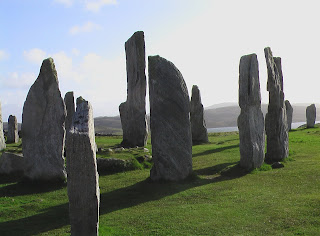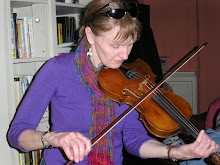
Friday 1 May. The ferry took us to the Outer Hebridean islands of Lewis and Harris today. We journey the 2:45 minutes by ferry because this is the land of Harris tweed. The definition of Harris tweed: made from the wool of Scottish sheep, spun in the Outer Hebrides, woven by hand, and finished in the Outer Hebrides. When the potato famine hit Scotland 1845-47, Lady Dunmore took the tweed the islanders were
 weaving, traveled the world, marked up the price 20x and came back and gave the weaver all the profit. Harris tweed became famous worldwide and the demand kept growing. Originally the tweed was naturally dyed. Crotal, a lichen, gave light to dark rusty color. Spinning mills came in 1907 and all the yarn was then aniline dyed.
weaving, traveled the world, marked up the price 20x and came back and gave the weaver all the profit. Harris tweed became famous worldwide and the demand kept growing. Originally the tweed was naturally dyed. Crotal, a lichen, gave light to dark rusty color. Spinning mills came in 1907 and all the yarn was then aniline dyed.In 1926, the Hattersley Loom greated increased the productivity of the weavers.
 The looms had hands free flying shuttle mechanisms and were powered by stepping alternately on two pedals. This is the loom you see Rodney, weaver at Gearranen Blackhouse Village weaving on as we stepped into the past to All the handweavers in our group marveled at the wonderful hands free, shuttle mechanism sends up to 6 different shuttles flying across the warp. The warp is 33" wide set 18 EPI with 18 PPI. In one and a half days, 100 yards could be woven on a Hattersly loom. http://www.gearrannan.com/
The looms had hands free flying shuttle mechanisms and were powered by stepping alternately on two pedals. This is the loom you see Rodney, weaver at Gearranen Blackhouse Village weaving on as we stepped into the past to All the handweavers in our group marveled at the wonderful hands free, shuttle mechanism sends up to 6 different shuttles flying across the warp. The warp is 33" wide set 18 EPI with 18 PPI. In one and a half days, 100 yards could be woven on a Hattersly loom. http://www.gearrannan.com/
Most of the 9 houses at Gearannen were built in the 1850’s. In 1989 a trust was formed to restore the houses and the village opened in 2000. When the blackhouses were built, they were long structures with an open plan. Animals lived and one end and people lived at the other. The roof was thatched. Blackhouses
 were very similar to the much earlier Viking long houses. Most had open fires in the middle of the living area. Medical officers required that dividing walls and windows be put into the houses by the turn of the century. Some also put in chimney’s. 50% of the rural population on the island still lived in blackhouses up to 1939. Mary, our guide, offered us these thoughts. “The people who lived in these houses were penniless. But they had a lot of thing we need here now…community spirit and tolerance. We are losing the richness of simplicity.”
were very similar to the much earlier Viking long houses. Most had open fires in the middle of the living area. Medical officers required that dividing walls and windows be put into the houses by the turn of the century. Some also put in chimney’s. 50% of the rural population on the island still lived in blackhouses up to 1939. Mary, our guide, offered us these thoughts. “The people who lived in these houses were penniless. But they had a lot of thing we need here now…community spirit and tolerance. We are losing the richness of simplicity.” Dun Carloway Broch rises up on hill in the midst of current day farms. Perhaps ¼ of the original broch still stands. But the impressive stonework remaining gives a good idea of
Dun Carloway Broch rises up on hill in the midst of current day farms. Perhaps ¼ of the original broch still stands. But the impressive stonework remaining gives a good idea of  what life in this multi-storied landowner’s home from the Iron age was like. We rain joined the high wind just as we arrived, so just a few of us blew up to the broch. www.stonepages.com/scotland/duncarloway
what life in this multi-storied landowner’s home from the Iron age was like. We rain joined the high wind just as we arrived, so just a few of us blew up to the broch. www.stonepages.com/scotland/duncarlowayOn the way to Callenish Standing Stones, we picked up local archeologist, Margaret Curtis
 For an hour she walked us around the stone formation, telling us what archeologists have discovered, about the formation over the past 200 years. She has lived in the area and worked on Callenish and the other stone circles and formations on the island for over 30 years. The cross formation of stones intersecting this circle sets it apart from stone circles we saw on Orkney. Callenish is the second largest stone circle in Britain, after Stonehenge. Margaret used illustration boards that showed us drawings of the formation before excavation removed several meters of peat. Much of her research has involved the location of the moon on it’s yearly path and how the moon
For an hour she walked us around the stone formation, telling us what archeologists have discovered, about the formation over the past 200 years. She has lived in the area and worked on Callenish and the other stone circles and formations on the island for over 30 years. The cross formation of stones intersecting this circle sets it apart from stone circles we saw on Orkney. Callenish is the second largest stone circle in Britain, after Stonehenge. Margaret used illustration boards that showed us drawings of the formation before excavation removed several meters of peat. Much of her research has involved the location of the moon on it’s yearly path and how the moon 
 aligns with certain stones. The sun alignment also enters into the story of the stones,
aligns with certain stones. The sun alignment also enters into the story of the stones,  Margaret doesn’t think the sun alignment was as important at this formation as the moon. Despite what felt like gale force winds, we followed Margaret dutifully around the formation as she engaged and enlighted us with her enthusiastic and informative insight into the mysteries of the stones.www.undiscoveredscotland.co.uk/lewis/calanais
Margaret doesn’t think the sun alignment was as important at this formation as the moon. Despite what felt like gale force winds, we followed Margaret dutifully around the formation as she engaged and enlighted us with her enthusiastic and informative insight into the mysteries of the stones.www.undiscoveredscotland.co.uk/lewis/calanaisHarris lies south of Lewis. The islands are actually connected by the road, but as you reach Harris, the hills rise up and the landscape becomes much more rocky. Harris also has brilliant sandy beaches. We stayed in Tarbert tonight. The name comes from the Norse word “tairbeart” meaning draw-boat. Here you get the feeling that if there was enough work enough, folks would never leave.

No comments:
Post a Comment